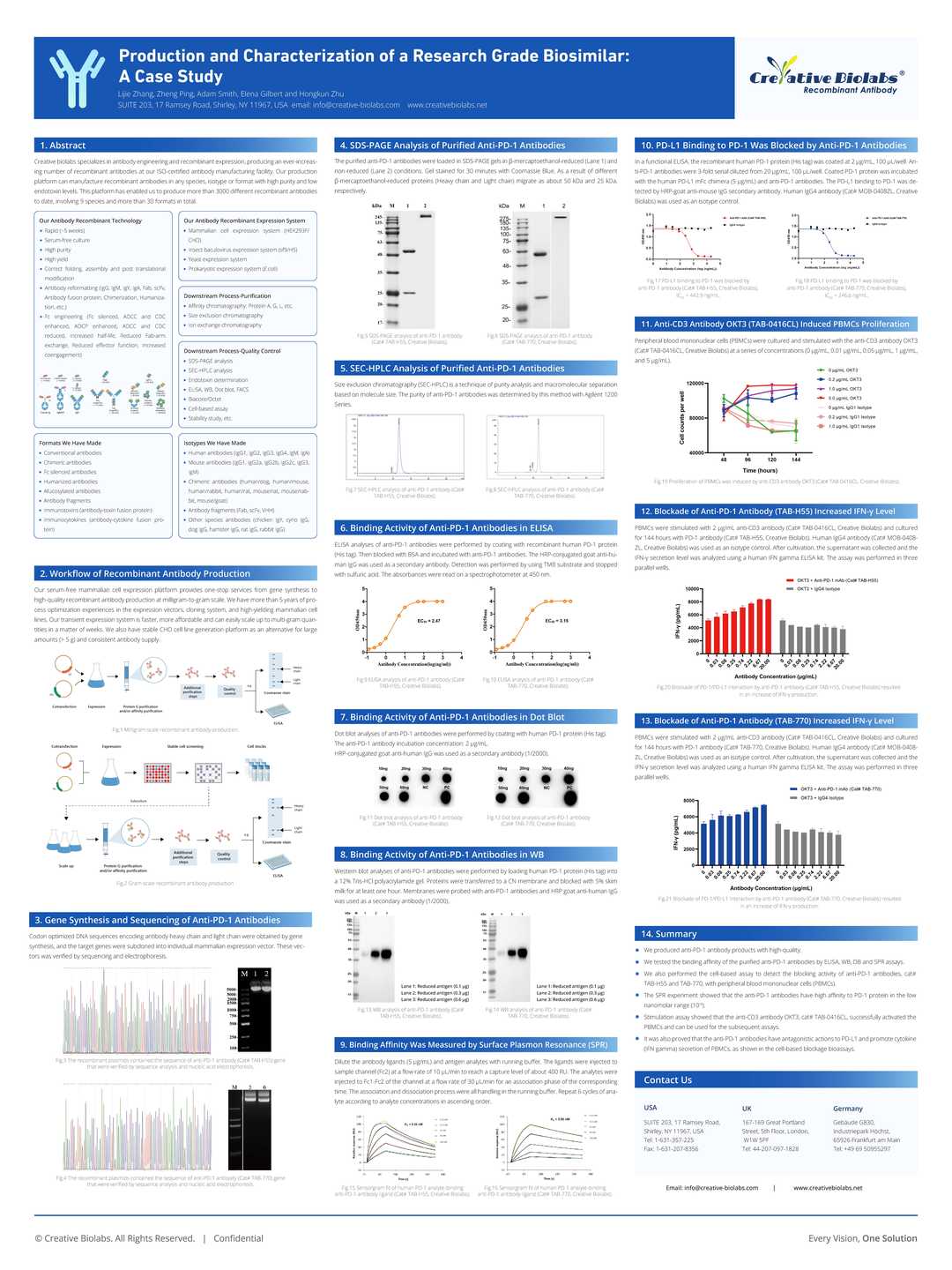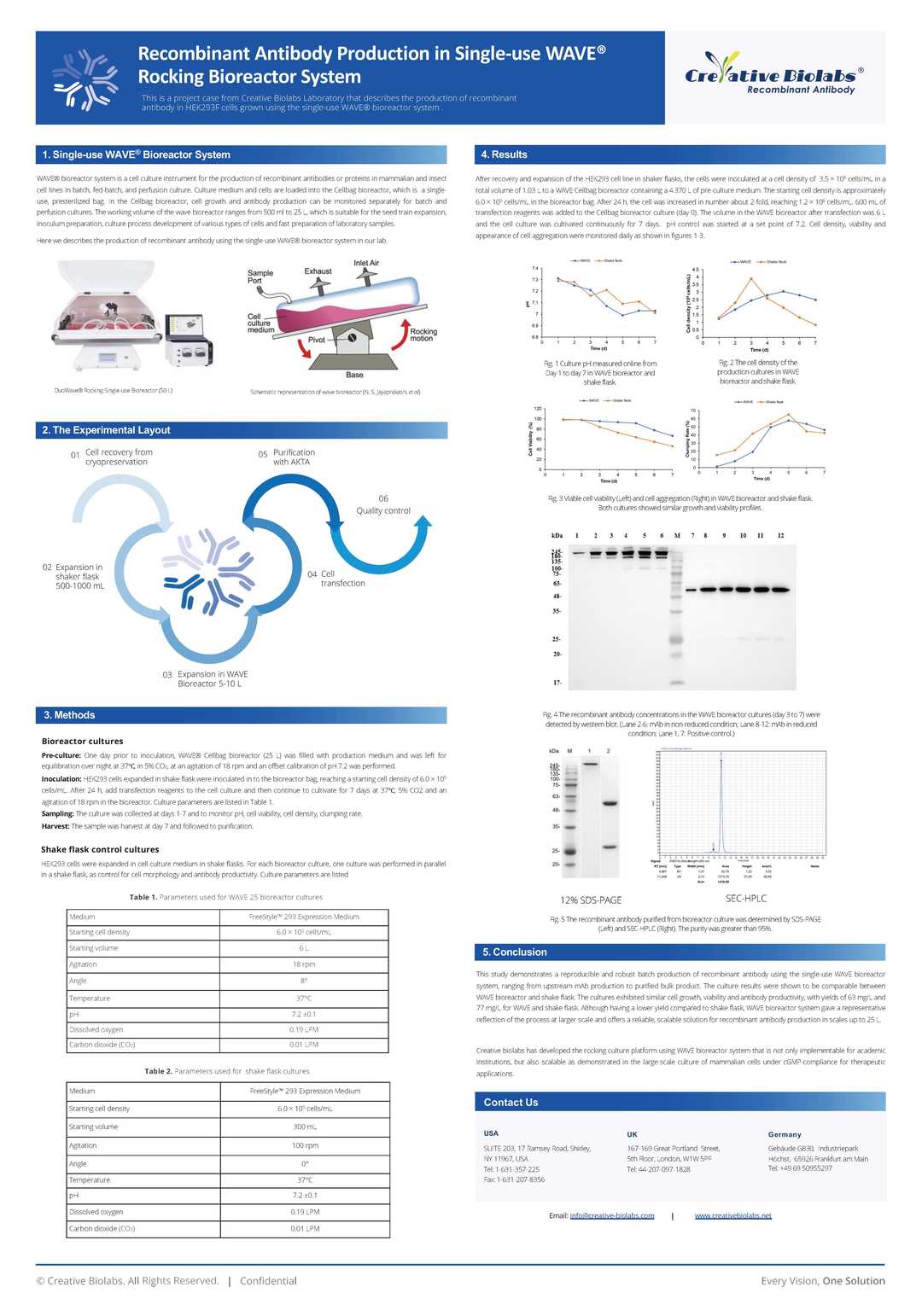Anti-Human folate receptor 1 Recombinant Antibody (TAB-113)
CAT#: TAB-113
Recombinant monoclonal antibody to folate receptor 1. It is a monoclonal antibody which is being investigated for the treatment of ovarian cancer, It is targeted at FR-alpha which is overexpressed in some cancers such as ovarian cancer.







Specifications
- Immunogen
- Gestational choriocarcinoma cell line, Lu-75.
- Host Species
- Human
- Derivation
- Humanized (from mouse)
- Type
- IgG1 - kappa
- Specificity
- Tested positive against native human antigen.
- Species Reactivity
- Human
- Applications
- FC, IP, ELISA, Neut, FuncS, IF, ICC, PK, Cyt
- MW
- 145.4 kDa
- Related Disease
- Ovarian cancers
Product Property
- Purity
- >95.0% as determined by Analysis by RP-HPLC & analysis by SDS-PAGE.
- Storage
- Store the antibody (in aliquots) at -20°C. Avoid repeated freezing and thawing of samples.
Applications
- Application Notes
- The FOLR1 antibody has been reported in applications of FC, IP, ELISA, Neut, FuncS, IF, ICC, PK, Cyt.
Target
Customer Review
There are currently no Customer reviews or questions for TAB-113. Click the button above to contact us or submit your feedback about this product.
Cite This Product
To accurately reference this product in your publication, please use the following citation information:
(Creative Biolabs Cat# TAB-113, RRID: AB_2941836)
Submit Your Publication
Published with our product? Submit your paper and receive a 10% discount on your next order! Share your research to earn exclusive rewards.
Biosimilar Overview
Please refer to Farletuzumab Overview to learn more about the mechanism of action, clinical projects, and approved drugs of Farletuzumab.
Downloadable Resources
Download resources about recombinant antibody development and antibody engineering to boost your research.
Product Notes
This is a product of Creative Biolabs' Hi-Affi™ recombinant antibody portfolio, which has several benefits including:
• Increased sensitivity
• Confirmed specificity
• High repeatability
• Excellent batch-to-batch consistency
• Sustainable supply
• Animal-free production
See more details about Hi-Affi™ recombinant antibody benefits.
Datasheet
MSDS
COA
Certificate of Analysis LookupTo download a Certificate of Analysis, please enter a lot number in the search box below. Note: Certificate of Analysis not available for kit components.
Protocol & Troubleshooting
We have outlined the assay protocols, covering reagents, solutions, procedures, and troubleshooting tips for common issues in order to better assist clients in conducting experiments with our products. View the full list of Protocol & Troubleshooting.
See other products for "FOLR1"
Select a product category from the dropdown menu below to view related products.
| CAT | Product Name | Application | Type |
|---|---|---|---|
| IAB-B029(A) | Recombinant Anti-human FOLR1 Intrabody [(D-Arg)9] | PCA, Neut, FuncS | scFv-(D-Arg)9 |
| IAB-B029(G) | Recombinant Anti-human FOLR1 Intrabody [+36 GFP] | WB, Neut, FuncS | scFv-(+36GFP) |
| IAB-B029(T) | Recombinant Anti-human FOLR1 Intrabody [Tat] | WB, ICC, Neut, FuncS | scFv-Tat |
| CAT | Product Name | Application | Type |
|---|---|---|---|
| TAB-016CQ | Human Anti-FOLR1 Recombinant Antibody (TAB-016CQ) | ELISA, FC, WB | Human IgG |
| TAB-016CQ-S(P) | Human Anti-FOLR1 Recombinant Antibody; scFv Fragment (TAB-016CQ-S(P)) | ELISA, FC, WB | Human scFv |
| TAB-016CQ-F(E) | Human Anti-FOLR1 Recombinant Antibody; Fab Fragment (TAB-016CQ-F(E)) | ELISA, FC, WB | Human Fab |
| TAB-382CQ | Anti-Human FOLR1 Recombinant Antibody (TAB-382CQ) | IHC | Human antibody |
| TAB-382CQ-F(E) | Anti-Human FOLR1 Recombinant Antibody Fab Fragment (TAB-382CQ-F(E)) | IHC | Human antibody |
| CAT | Product Name | Application | Type |
|---|---|---|---|
| TAB-017CQ | Rat Anti-FOLR1 Recombinant Antibody (TAB-017CQ) | ELISA, WB, IHC | Rat IgG1, κ |
| TAB-020CQ | Mouse Anti-FOLR1 Recombinant Antibody (TAB-020CQ) | ELISA, FC, WB, IHC | Mouse IgG1 |
| TAB-017CQ-S(P) | Rat Anti-FOLR1 Recombinant Antibody; scFv Fragment (TAB-017CQ-S(P)) | ELISA, WB, IHC | Rat scFv |
| TAB-017CQ-F(E) | Rat Anti-FOLR1 Recombinant Antibody; Fab Fragment (TAB-017CQ-F(E)) | ELISA, WB, IHC | Rat Fab |
| TAB-020CQ-F(E) | Mouse Anti-FOLR1 Recombinant Antibody; Fab Fragment (TAB-020CQ-F(E)) | ELISA, FC, WB, IHC | Mouse Fab |
| CAT | Product Name | Application | Type |
|---|---|---|---|
| TAB-018CQ | Human Anti-FOLR1 Recombinant Antibody (TAB-018CQ) | ELISA, WB, IHC | Chimeric (Rat/Human) IgG1, κ |
| TAB-018CQ-S(P) | Human Anti-FOLR1 Recombinant Antibody; scFv Fragment (TAB-018CQ-S(P)) | ELISA, WB, IHC | Human scFv |
| TAB-018CQ-F(E) | Human Anti-FOLR1 Recombinant Antibody; Fab Fragment (TAB-018CQ-F(E)) | ELISA, WB, IHC | Chimeric (Rat/Human) Fab |
| CAT | Product Name | Application | Type |
|---|---|---|---|
| TAB-019CQ | Human Anti-FOLR1 Recombinant Antibody (TAB-019CQ) | ELISA, WB, IHC | Human IgG1, κ |
| TAB-019CQ-S(P) | Human Anti-FOLR1 Recombinant Antibody; scFv Fragment (TAB-019CQ-S(P)) | ELISA, WB, IHC | Human scFv |
| TAB-019CQ-F(E) | Human Anti-FOLR1 Recombinant Antibody; Fab Fragment (TAB-019CQ-F(E)) | ELISA, WB, IHC | Humanized Fab |
| CAT | Product Name | Application | Type |
|---|---|---|---|
| Gly-029LC | Recombinant Anti-Human FOLR1 Antibody (Fc glycosylation/Non fucosylated) | ELISA | Human antibody |
| Gly-030LC | Recombinant Anti-Human FOLR1 Antibody (Fc glycosylation) | ELISA | Human antibody |
| Gly-116LC | Recombinant Anti-Human FOLR1 Antibody (Fc glycosylation) | ELISA | Human antibody |
| CAT | Product Name | Application | Type |
|---|---|---|---|
| Gly-029LC-1 | Recombinant Anti-Human FOLR1 Antibody (Fc glycosylation/Non fucosylated) | ELISA | Human antibody |
| CAT | Product Name | Application | Type |
|---|---|---|---|
| MOR-1333 | Hi-Affi™ Rabbit Anti-FOLR1 Recombinant Antibody (clone DS1333AB) | WB | Rabbit IgG |
| CAT | Product Name | Application | Type |
|---|---|---|---|
| HPAB-0115-CN | Mouse Anti-FOLR1 Recombinant Antibody (HPAB-0115-CN) | ELISA, FC, IHC | Mouse IgG2b |
| HPAB-0116-CN | Human Anti-FOLR1 Recombinant Antibody (HPAB-0116-CN) | ELISA, FC, IHC | Humanized IgG1 |
| VS-0723-WK144 | Human Anti-FOLR1 Recombinant Antibody (VS-0723-WK144) | FC | Chimeric (rabbit/human) IgG1 |
| VS7-HM960 | Mouse Anti-FOLR1 Recombinant Antibody (clone 3G12B7) | FCM | Mouse IgG1 |
| VS7-HM961 | Mouse Anti-FOLR1 Recombinant Antibody (clone 2G5C12) | IHC, ICC, FCM | Mouse IgG2a |
| CAT | Product Name | Application | Type |
|---|---|---|---|
| HPAB-0115-CN-S(P) | Mouse Anti-FOLR1 Recombinant Antibody; scFv Fragment (HPAB-0115-CN-S(P)) | ELISA, FC, IHC | Mouse scFv |
| HPAB-0116-CN-S(P) | Human Anti-FOLR1 Recombinant Antibody; scFv Fragment (HPAB-0116-CN-S(P)) | ELISA, FC, IHC | Humanized scFv |
| HPAB-0117-CN-S(P) | Mouse Anti-FOLR1 Recombinant Antibody; scFv Fragment (HPAB-0117-CN-S(P)) | ELISA, FC | Mouse scFv |
| HPAB-0080-FY-S(P) | Human Anti-FOLR1 Recombinant Antibody; scFv Fragment (HPAB-0080-FY-S(P)) | FC | Human scFv |
| HPAB-M0094-YC-S(P) | Human Anti-FOLR1 Recombinant Antibody; scFv Fragment (HPAB-M0094-YC-S(P)) | FuncS | Humanized scFv |
| CAT | Product Name | Application | Type |
|---|---|---|---|
| HPAB-0115-CN-F(E) | Mouse Anti-FOLR1 Recombinant Antibody; Fab Fragment (HPAB-0115-CN-F(E)) | ELISA, FC, IHC | Mouse Fab |
| HPAB-0312-WJ-F(E) | Mouse Anti-FOLR1 Recombinant Antibody; Fab Fragment (HPAB-0312-WJ-F(E)) | ELISA, IHC, FC | Mouse Fab |
| HPAB-0313-WJ-F(E) | Mouse Anti-FOLR1 Recombinant Antibody; Fab Fragment (HPAB-0313-WJ-F(E)) | ELISA, IHC, FC | Mouse Fab |
| HPAB-0314-WJ-F(E) | Mouse Anti-FOLR1 Recombinant Antibody; Fab Fragment (HPAB-0314-WJ-F(E)) | ELISA, IHC, FC | Mouse Fab |
| HPAB-M0094-YC-F(E) | Human Anti-FOLR1 Recombinant Antibody; Fab Fragment (HPAB-M0094-YC-F(E)) | FuncS | Humanized Fab |
| CAT | Product Name | Application | Type |
|---|---|---|---|
| AFC-TAB-113 | Afuco™ Anti-FOLR1 ADCC Recombinant Antibody, ADCC Enhanced (AFC-TAB-113) | FC, IP, ELISA, Neut, FuncS, IF | ADCC enhanced antibody |
| CAT | Product Name | Application | Type |
|---|---|---|---|
| MHC-CN0049 | APC-A*02:01/Human FBP (EIWTHSYKV) MHC Tetramer | FCM | |
| MHC-CN0050 | PE-A*02:01/Human FBP (EIWTHSYKV) MHC Tetramer | FCM | |
| MHC-CN0685 | PE-A*02:01/Human FOLR1 (EIWTHSYKV) MHC Tetramer | FCM, IHC | |
| MHC-CN0686 | APC-A*02:01/Human FOLR1 (EIWTHSYKV) MHC Tetramer | FCM, IHC | |
| MHC-CN0687 | FITC-A*02:01/Human FOLR1 (EIWTHSYKV) MHC Tetramer | FCM, IHC |
| CAT | Product Name | Application | Type |
|---|---|---|---|
| VS-0325-FY70 | Human Anti-FOLR1 (clone Farletuzumab) scFv-Fc Chimera | ELISA, Inhib | Human IgG1, scFv-Fc |
| CAT | Product Name | Application | Type |
|---|---|---|---|
| VS-0425-YC262 | Recombinant Anti-FOLR1 Vesicular Antibody, EV Displayed (VS-0425-YC262) | ELISA, FC, Neut, Cell-uptake |
| CAT | Product Name | Application | Type |
|---|---|---|---|
| VS-0525-XY2606 | Anti-FOLR1 Immunohistochemistry Kit | IHC |
| CAT | Product Name | Application | Type |
|---|---|---|---|
| VS-0525-YC13 | Recombinant Anti-FOLR1 Biparatopic Antibody, Asymmetric scFv-Fab | ELISA | Asymmetric scFv-Fab |
| CAT | Product Name | Application | Type |
|---|---|---|---|
| VS-0825-YC140 | SmartAb™ Recombinant Anti-FOLR1 pH-dependent Antibody (VS-0825-YC140) | FC, IP, ELISA, Neut, IF, ICC | Human IgG1 kappa |
Popular Products

Application: WB, FuncS, IF, Neut, ELISA, FC, IP

Application: FC, IP, ELISA, Neut, FuncS, IF, ICC

Application: WB, IHC, FC, Cyt, ELISA

Application: ELISA, Inhib, FC

Application: ELISA, IHC, FC, IP, IF, FuncS

Application: ELISA, IHC, FC, IP, IF, Inhib

Application: ELISA, WB, FC, IHC, IP
-4.jpg)
Application: FC, FuncS, IA, IF, IP, IHC
For research use only. Not intended for any clinical use. No products from Creative Biolabs may be resold, modified for resale or used to manufacture commercial products without prior written approval from Creative Biolabs.
This site is protected by reCAPTCHA and the Google Privacy Policy and Terms of Service apply.


















-5.jpg)






